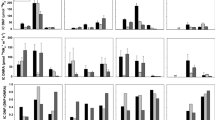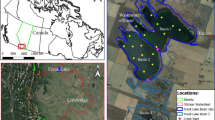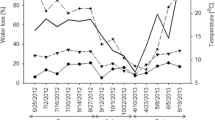Abstract
A beaver pond and its associated inlet and outlet waters in the Adirondack Mountains of New York were monitored for major chemical solutes for 26 months in an effort to quantify underlying chemical controls on the production and consumption of acid neutralizing capacity (ANC). The pond was a net annual sink for inlet Al, SO4 2−, NO3 −; and H4SiO4. The pond was a net annual source of dissolved organic carbon (DOC), NH4 +, and Fe2−. Losses of ANC resulting from Al and basic cation retention, as well as organic anion release (RCOO−) associated with DOC, were more than offset by SO4 2−, and NO3 − retention and Fe2− and NH4 + release, resulting in a net production of ANC. Rates of ANC generation were 120 meq m−2 yr−1 and 310 meq m−2 yr−1, respectively (based on pond surface area), for the non-summer (October-June) and summer (July–September) periods. Seasonal variations in ANC in the outlet stream were largely associated with Fe2+ and DOC release, while ANC in the upland inlet stream was associated with Al, NO3 −, and basic cations, with much less seasonal variation. Controls on stream chemistry were temporally and longitudinally different, for the inlet and outlet streams. The shift to seasonal control of outlet stream ANC by processes associated with organic matter decomposition reactions and anaerobic zone nutrient transformations may be characteristic of headwater wetlands, in temperate zones with seasonal temperature extremes. Beaver impoundments and wetlands may also be important in the upstream mobilization or retention of geologically bound solutes like Al, Fe, and H4SiO4. Headwater wetlands, as sinks for solutes associated with acidic deposition and watershed acidification (i.e., SO4 2−, NO3 −, and Al), may play a role in the amelioration of the effects of these solutes on downstream receiving waters and associated biota. Depending on their location in relation to drainage patterns, these ponded systems may influence the nutrient dynamics of receiving waters through nitrogen transformations and organic carbon cycling.
Similar content being viewed by others
Literature Cited
Aber, J.D., K.J. Nadelhoffer, P. Steudler, and J.M. Mellillo. 1989. Nitrogen saturation in northern forest ecosystems. Bioscience 39: 378–386.
American Public Health Association. 1985. Standard Methods for the Examination of Water and Wastewater. American Public Health Association. New York, NY, USA.
Andrus, R.E. 1986. Some aspects ofSphagnum ecology. Canadian Journal of Botany 64:416–426.
Apple, L.L. 1985. Riparian habitat restoration and beavers. p. 489–490.In R.R. Johnson, C.D. Ziebell, D.R. Patton, P.F. Pfolliott, and R.H. Hamre (tech. coords.) Riparian Ecosystems and Their Management: Reconciling Conflicting Uses. General Technical Report RM-120. Rocky Mountain Forest and Range Experiment Station, USDA Forest Service, Tucson, AZ, USA.
April, R. and R.M. Newton. 1985. Influence of geology on lake acidification in the ILWAS watersheds. Water Air and Soil Pollution 26:373–386.
Aulenbach, B. 1992. Streamflow generation and episodic acidification during hydrologic events at Woods Lake, Adirondack Mountains, New York, USA. Masters Thesis, Syracuse University, Syracuse, NY, USA.
Bayley, S.E., R.S. Behr, and C.A. Kelly. 1986. Retention and release of S from a freshwater wetland. Water Air and Soil Pollution 31:101–114.
Bayley, S.E., D.H. Vitt, R.W. Newbury, K.G. Beaty, R. Behr, and C. Miller. 1987. Experimental acidification of aSphagnum dominated peatland: first year results. Canadian Journal of Fisheries and Aquatic Sciences 44:194–205.
Bennett, P.C., D.I. Siegel, B.M. Hill, and P.H. Glaser. 1991. Fate of silicate minerals in a peat bog. Geology 19:328–331.
Cappo, K.A., L.J. Blume, G.A. Raab, J.K. Bartz, and J.L. Engels. 1987. Analytical Methods Manual for the Direct/Delayed Response Project Soil Survey. United States Environmental Protection Agency, Environmental Monitoring Systems Laboratory, Office of Research and Development, Las Vegas, NV, USA. EPA 600/8-87/020.
Clymo, R.S. 1963. Ion exchange inSphagnum and its relation to bog ecology. Annals of Botany (New Series) 27:309–324.
Cook, R.B., C.A. Kelly, D.W. Schindler, and D.A. Turner. 1986. Mechanisms of hydrogen ion neutralization in an experimentally acidified lake. Limnology and Oceanography 31:134–148.
Cook, R.B., K.A. Rose, A.L. Brenkert, and P.F. Ryan. 1992. Systematic comparison of ILWAS, MAGIC, and ETD watershed acidification models: 3. Mass balance budgets for acid neutralizing capacity. Environmental Pollution 77:235–242.
Craigie, J.S. and W.S.G. Maass. 1966. The cation exchanger inSphagnum spp. Annals of Botany (London, New Series) 30:153–154.
Dahm, C.N., E.H. Trotter, and J.R. Sedell. 1987. Role of anaerobic zones and processes in stream ecosystem productivity. p. 157–178.In R.C. Averett and D.M. McKnight (eds.) Chemical Quality of Water and the Hydrologic Cycle. Lewis Publishers, Inc., Chelsea, MI, USA.
DeVito, K.J., P.J. Dillon, and B.D. LaZerte. 1989. Phosphorus and nitrogen retention in five Precambrian shield wetlands. Biogeochemistry 8:185–204.
Dohrmann Operatoral Manual. 1984. Automated Laboratory Total Carbon Analyzer. Zertex Corp., Santa Clara, CA, USA.
Driscoll, C.T., J.P. Baker, J.J. Bisogni, and C.L. Schofield. 1980. Effect of aluminum speciation on fish in dilute acidified waters. Nature (London) 284:161–164.
Driscoll, C.T. 1984. A procedure for the fractionation of aqueous aluminum in dilute acidic waters. International Journal of Environmental Analytical Chemistry 16:267–284.
Driscoll, C.T., R.D. Fuller, and W.D. Schecher. 1989. The role of organic acids in the acidification of surface waters in the eastern United States. Water Air and Soil Pollution 43:21–40.
Driscoll, C.T., M.D. Lehtinen, and T.J. Sullivan. 1993. Modeling the acid-base chemistry of organic solutes in Adirondack, NY, lakes. Water Resources Research (in-press).
Driscoll, C.T. and R. van Dreason. 1993. Seasonal and long-term temporal patterns in the chemistry of Adirondack Lakes. Water Air and Soil Pollution 67:319–344.
Driscoll, C.T., B.J. Wyskowski, C.C. Cosentini, and M.E. Smith. 1987. Processes regulating temporal and longitudinal variations in the chemistry of a low-order stream in the Adirondack region of New York. Biogeochemistry 3:225–241.
Ford, T.E. and R.J. Naiman. 1988. Alteration of carbon cycling by beaver: methane evasion rates from boreal forest streams and rivers. Canadian Journal of Zoology 66:529–533.
Fordham, G.F. and C.T. Driscoll. 1989. Short-term changes in the acid/base chemistry of two acidic lakes following calcium carbonate treatment. Canadian Journal of Fisheries and Aquatic Sciences 46:306–314.
Francis, M.M., R.J. Naiman, and J.M. Melillo. 1985. Nitrogen fixation in subarctic streams influenced by beaver (Castor canadensis). Hydrobiologia 121:193–202.
Fry, B. 1986. Stable sulfur isotopic distributions and sulfate reduction in lake sediments of the Adirondack Mountains, New York. Biogeochemistry 2:329–343.
Goldstein, R.A., S.A. Gherini, C.T. Driscoll, R. April, C.L. Schofield, and C.W. Chen. 1987. Lake-watershed acidification in the North Branch of the Moose River: Introduction. Biogeochemistry 3:5–20.
Gorham, E., S.E. Bayley, and D.W. Schindler. 1984. Ecological effects of acid deposition on peatlands: A neglected field of acid rain research. Canadian Journal of Fisheries and Aquatic Sciences 41:1256–1268.
Gorham, E., S.J. Eisenreich, J. Ford, and M.V. Santelmann. 1985. The chemistry of bog waters. p. 339–363.In W. Stumm (ed.) Chemical Processes in Lakes. Wiley-InterScience, New York, NY, USA.
Gran, G. 1952. Determination of the equivalence point in potentiometric titration. International Congress of Chemistry 77:661–671.
Gubala, C.P. and C.T. Driscoll. 1990. The influence of a beaver impoundment upon the acid-base chemistry within a small Adirondack catchment. Meeting Abstract, American Chemical Society 199:146.
Hall, R.J., C.T. Driscoll, G.E. Likens, and J.M. Pratt. 1985. Physical, chemical and biological consequences of episodic aluminum additions to a stream ecosystem. Limnology and Oceanography 30:212–220.
Hemond, H.F. 1990. Acid neutralizing capacity, alkalinity and acid-base status of natural waters containing organic acids. Environmental Science and Technology 24:1486–1489.
Hiebert, F.K. and P.C. Bennett. 1992. Microbial control of silicate weathering in organic-rich ground water. Science 258:278–281.
Hodkinson, I.D. 1975. Energy flow and organic matter decomposition in an abandoned beaver pond system. Oecologia 21:131–139.
Johnston, C.A. and R.J. Naiman. 1987. Boundary dynamics at the aquatic-terrestrial interface: the influence of beaver and geomorphology. Landscape Ecology 1:47–57.
Johnston, C.A. and R.J. Naiman. 1990. Aquatic patch creation in relation to beaver population trends. Ecology 71:1617–1621.
Kelly C.A., J.W.M. Rudd, R.B. Cook, and D.W. Schindler. 1982. The potential importance of bacterial processes in regulating rate of lake acidification. Limnology and Oceanography 27:868–882.
Kelly, C.A. and J.W.M. Rudd. 1984. Epilimnetic sulfate reduction and its relationship to lake acidification. Biogeochemistry 1:63–77.
Kerekes, J., S. Beauchamp, R. Torden, and T. Pollock. 1986. Sources of sulphate and acidity in wetlands and lakes of Nova Scotia. Water Air and Soil Pollution 31:207–214.
LaZerte, B.D. 1993. The impact of drought and acidification on the chemical exports from a minerotrophic conifer swamp. Biogeochemistry 18:153–175.
Lovley, D.R. and E.J.P. Phillips. 1986a. Organic matter mineralization with reduction of ferric iron in anaerobic sediments. Applied Environmental Microbiology 51:683–689.
Lovley, D.R. and E.J.P. Phillips. 1986b. Availability of ferric iron for microbial reduction in bottom sediments of the freshwater tidal Potomac River. Applied Environmental Microbiology 52: 751–757.
Madsen, E.L., M.D. Morgan and R.E. Good. 1986. Simultaneous photo-reduction and microbial oxidation of iron in a stream in the New Jersey Pinelands. Limnology and Oceanography 31:832–838.
Maret, J.J., M. Parker, and T.E. Fanny. 1987. The effect of beaver ponds on the non-point source water quality of a stream in southwestern Wyoming. Water Research 21:263–268.
McKnight, D.M., B.A. Kimball, and K.E. Bencala. 1988. Iron photo-reduction and oxidation in an acidic mountain stream. Science 240:637–640.
Munson, R.K., C.T. Driscoll, and S.A. Gherini. 1990a. Phenomenological analysis of ALSC chemistry data. p.(2-27)–(2-69).In Adirondack Lakes Survey: An Interpretive Analysis of Fish Communities and Water Chemistry, 1984–1987. Adirondack Lakes Survey Corporation. Ray Brook, NY, USA.
Munson, R.K., S.A. Gherini, K.H. Reckhow, and C.T. Driscoll. 1990b. Integrated analysis. p.(2-92)–(2-110).In Adirondack Lakes Survey: An Interpretive Analysis of Fish Communities and Water Chemistry, 1984–1987. Adirondack Lakes Survey Corporation, Ray Brook, NY, USA.
Munson, R.K. and S.A. Gherini. 1993. Influence of organic acids on pH and acid-neutralizing capacity of Adirondack lakes. Water Resources Research 29:891–899.
Naiman, R.J., C.A. Johnston, and J.C. Kelley. 1988. Alteration of North American streams by beaver. BioScience 38:753–762.
Naiman, R.J., T. Manning, and C.A. Johnston. 1991. Beaver population fluctuations and tropospheric methane emissions in boreal wetlands. Biogeochemistry 12:1–15.
Naiman, R.J. and J.M. Mellillo. 1984. Nitrogen budget of a subarctic stream altered by beaver (Castor canadensis). Oecologia 62: 150–155.
Naiman, R.J., J.M. Melillo, and J.E. Hobbie. 1986. Ecosystem alteration of boreal forest streams by beaver (Castor canadensis). Ecology 67:1254–1269.
New York State Atmospheric Deposition Monitoring Network. 1991. Wet deposition, Nicks Lake, 1991. New York State Department of Environmental Conservation, Division of Air Resources, Albany, NY, USA.
Nisbet, E.G. 1989. Some northern sources of atmospheric methane: production, history and future implications. Canadian Journal of Earth Sciences 26:1603–1611.
Nriagu, J.O. and Y.K. Soon. 1985. Distribution and isotopic composition of sulfur in lake sediments of northern Ontario. Geochimica et Cosmochimica Acta 49:823–834.
Orion Instruction Manual. 1976. Fluoride Electrodes. Orion Research Inc., Cambridge, MA, USA.
Parker, M. 1986. Beaver, water quality, and riparian systems. p. 88–94.In Proceedings: Wyoming Water and Streamside Zone Conference. Wyoming Water Research Center, University of Wyoming, Laramie, NY, USA.
Perdue, E.M. 1985. Acidic functional groups of humic substances. p. 493–526.In G.R. Aiken, D.M. McKnight, R.L. Wershaw, and P. MacCarthy (eds.) Humic Substances in Soil Sediments and Water. Wiley-InterScience, New York, NY, USA.
Remillard, M.M., G.K. Gruendling, and D.J. Bogucki. 1987. Disturbance by beaver (Castor canadensis Kuhl) and increased landscape heterogeneity. p. 103–122.In Landscape Heterogeneity and Disturbance: Ecological Studies #64. Springer-Verlag Inc., New York, NY, USA.
Roulet, N.T. and R. Ash. 1992. Low boreal wetlands as a source of atmospheric methane. Journal of Geophysical Research 97: 3739–3749.
SAS Institute Inc. 1985. SAS Procedures Guide for Personal Computers, Version 6 Edition. Cary, NC, USA.
Schafran, G.C. and C.T. Driscoll. 1987. Comparison of terrestrial and hypolimnetic sediment generation of acid neutralizing capacity for an acidic Adirondack Lake. Environmental Science and Technology 21:988–993.
Schecher, W.D. and C.T. Driscoll. 1993. ALCHEMI: A chemical equilibrium model to assess the acid-base chemistry and speciation of aluminum in dilute solutions.In R. Loeppert, A.P. Schwab, and S. Goldberg (eds.) Chemical Equilibrium and Reaction Models. Soil Science Society of America, Madison, WI, USA (in-press).
Schiff, S.L. and R.F. Anderson. 1986. Alkalinity production in epilimnetic sediments: acidic and non-acidic lakes. Water Air and Soil Pollution 31:941–948.
Schindler, D.W. 1986. The significance of in-lake production of alkalinity. Water Air and Soil Pollution 30:931–944.
Schindler, D.W., R. Wagemann, R.B. Cook, T. Ruszczyunski, and J. Prokopowich. 1980. Experimental acidification of Lake 223, Experimental Lakes Area: background data and the first three years of acidification. Canadian Journal of Fisheries and Aquatic Sciences 37:342–354.
Schofield, C.L. and J.R. Trojnar. 1980. Aluminum toxicity to brook trout (Salvelinus fontinalis) in acidified waters. p. 347–366.In T.Y. Toribara, M.W. Miller and P.E. Morrow (eds.) Polluted Rain. Plenum Press, New York, NY, USA.
Schofield, C.L. 1993. Habitat suitability for brook trout (Salvelinus fontinalis) reproduction in Adirondack lakes. Water Resources Research 77:875–879.
Slavin, W. 1968. Atomic absorption Spectroscopy. John Wiley InterScience, New York, NY, USA.
Small, H., T.S. Stevens, and W.C. Bauman. 1975. Novel ion exchange chromatographic method using conductimetric detection. Analytical Chemistry 47:1801–1809.
Smith, M.E., C.T. Driscoll, B.J. Wyskowski, C.M. Brooks, and C.C. Cosentini. 1991. Modification of stream ecosystem structure and function by beaver (Castor canadensis) in the Adirondack Mountains, New York. Canadian Journal of Zoology 69:55–61.
Stoddard, J.L. and P.S. Murdoch. 1991. Catskill Mountains. p. 237–271.In D.F. Charles (ed.) Acidic Deposition and Aquatic Ecosystems: Regional Case Studies. Springer-Verlag, Inc., New York, NY, USA.
Stuiver, M. 1967. The sulfur cycle in lake waters during thermal stratification. Geochimica et Cosmochimica Acta 31:2151–2167.
Stumm, W. and J.J. Morgan. 1981. Aquatic Chemistry (2nd. ed.), John Wiley and Sons, Inc., New York, NY, USA.
Tipping, E., C.A. Bakkes, and M.A. Hurley, 1988. The complexation of protons, aluminum and calcium by aquatic humic substances: A model incorporating binding-site heterogeneity and macroionic effects. Water Research 22:597–564.
Urban, N.R. and S.E. Bayley. 1986. The acid-base balance of peatlands: a short term perspective. Water Air and Soil Pollution 30: 791–800.
Urban, N.R., S.J. Eisenreich, and D.F. Grigal. 1989. Sulphur cycling in a forestedSphagnum bog in northern Minnesota. Biogeochemistry 7:81–109.
Vogt, K.A., R. Dahlgren, F.C. Ugolini, D. Zabowski, E.E. Moore, and R. Zasoski. 1987. Aluminum, Fe, Ca, Mg, K, Mn, Cu, Zn and P in above-and below-ground biomass. Part I. Concentrations in subalpineAbies amabilis andTsuga mertensiana. Biogeochemistry. 4:295–311.
Wieder, R.K., G.E. Lang, and V.A. Granus. 1987. Sulphur transformations inSphagnum-derived peat during incubation. Soil Biology and Biochemistry 19:101–106.
Woo, M.K. and J.M. Waddington. 1990. Effects of beaver dams on sub-arctic wetland hydrology. Aretic 43:223–230.
Wood, J.A. 1989. Peatland acidity budgets and the effects of acid deposition. Discussion Paper No. 5., Ecological Applications Research Division, Environment Canada. Ottawa, Ontario, Canada.
Yavitt, J.B., L. Angell, T.J. Fahey, C.P. Cirmo, and C.T. Driscoll. 1992. Methane fluxes, concentrations and production in two Adirondack beaver impoundments. Limnology and Oceanography 37:1057–1066.
Yavitt, J.B., G.E. Lang, and A.J. Sextone. 1990. Methane fluxes in wetland forest and soils, beaver ponds, and low-order streams of a temperate forest ecosystem. Journal of Geophysical Research (Oceans) 95:22463–22474.
Author information
Authors and Affiliations
Rights and permissions
About this article
Cite this article
Cirmo, C.P., Driscoll, C.T. Beaver pond biogeochemistry: Acid neutralizing capacity generation in a headwater wetland. Wetlands 13, 277–292 (1993). https://doi.org/10.1007/BF03161294
Received:
Accepted:
Issue Date:
DOI: https://doi.org/10.1007/BF03161294




